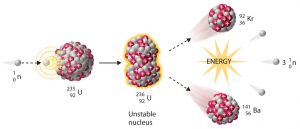For over half a century now Hydrogen Fusion has been the Holy Grail of energy production for the human race. Fusion is the energy source that powers the stars themselves and the potential for Fusion power plants to provide cheap, inexhaustible, pollution free energy was never in doubt. The question has always been whether the extreme conditions necessary for Fusion to occur could be controlled and maintained, whether a reliable Fusion reactor was possible or, like the Holy Grail, just a dream.
Let me take a moment to provide a little background. The chemical elements we’re all familiar with from high school run from the simple ones like Hydrogen, just a proton and electron, to extremely complex ones such as Uranium with 92 protons, 92 electrons along with 146 neutrons.
Now it turns out that you can release energy by either splitting big atoms like Uranium, this is called Fission, or Fusing small ones like taking 4 Hydrogen atoms to form one Helium atom. The pictures below show the two different types of reactions.


We all know that Atomic Fission reactors have been producing energy for over 50 years but they’re dangerous, even after you’ve shut them down they remain hot and if the reaction gets out of control a tremendous amount of harmful radiation can be released, as in Chernobyl or Fukashima. Another problem with Fission reactors is that the leftover fuel rods are also highly radioactive and storing them safely is a very difficult problem.
Fusion reactors on the other hand would have a number of clear advantages. First of all Hydrogen Fusion simply produces more energy per kilo of fuel. More importantly however is the fact that Fusion would produce zero dangerous waste. Also, the conditions needed to produce Fusion are difficult to initiate and maintain, so difficult in fact that if anything were to go wrong the reaction would just instantly stop with no chance of a meltdown or release of radiation.
So if Fusion is such a better form of energy production why aren’t we building them by the hundreds in order to satisfy the need for pollution free energy? Well, as I said the conditions needed for Fusion are difficult to initiate and maintain, so difficult in fact that the world’s best scientists have been unable to maintain a Fusion reaction for more than a fraction of a second.
A recent advance may help to change that however. Scientists at MIT’s Plasma Science and Fusion Center have been experimenting with a new recipe for the fuel in their Alcator C-Mod Tokamak reactor. Now a Tokamak is a doughnut shaped vacuum chamber that uses intense magnetic fields to confine plasma, a gas of atoms that have been stripped of one or more electrons. Producing and heating plasma to extremely high temperatures and pressures is how you initiate a Fusion reaction. The picture below shows the MIT Tokamak.

For the last several decades the fuel recipe that researchers have used has consisted of about 5% ordinary Hydrogen and 95% Deuterium, Hydrogen with a neutron attached to the proton. Microwaves then heat the ordinary Hydrogen and Fusion occurs as the superheated Hydrogen slams into the Deuterium. As I said earlier no one has succeeded in keeping this reaction going for more than a second.
Now the team at MIT has added a trace, less than 1%, of Helium-3 to the mixture. (Helium-3 is an atom of Helium lacking a neutron) When the Helium-3 is heated by microwaves they were able to increase the Helium-3 to energy levels ten times greater than previously seen!
The results obtained by the MIT team were so exciting that they quickly shared their results with colleagues at the Joint European Torus (JET in Culham UK), which is the world’s largest experimental Fusion reactor. The JET team soon confirmed MIT’s results and so now both teams are fine-tuning the recipe in order to get the highest energy levels possible.
Whether or not this breakthrough will soon lead to practical Nuclear Fusion only time will tell. It is possible however that before too long humanity may possess an almost limitless supply of pollution free energy.
If you’d like to read more about the research at MIT click on the link below to be taken to the Plasma Science and Fusion Center webpage.
https://www.psfc.mit.edu/news/2017/fusion-heating-gets-a-boost
